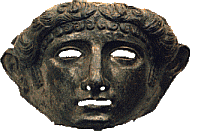
Dramatic Construction
 Dramatic Construction |
Plotting out the scenes is a good way of seeing how a play works. Outlining a play may seem jejune to some, but it helps the reader grasp the construction. Who is on stage? Where did they come from? How often are the children brought before our eyes and kept there? What kinds of arguments do adversaries use in the debate scenes? Who wins (probably nobody: the outcome of the agon, or debate , is almost always a draw)? What words, actions, and gestures are repeated? Which scenes go over the past? What happens behind the scenes in the two offstage elsewheres (Medea's house and the palace of the royal family) which are so prominent by their absence? How do the choral odes pick up the themes of the scenes surrounding them?The Medea is a beautifully constructed drama in ring composition.11
Choral Movements
The choral odes (or stasima) are divided into strophes and antistrophes (or stanzas and answering stanzas) which are metrically equivalent to each other. In the Medea the odes all have two sets of strophe/antistrophe. In his recent book Tragedy in Athens: Performance space and theatrical meaning, David Wiles argues for identical choreography in strophe and antistrophe (Chapter 4, esp. 96-7). A simple way of seeing how the paired stanzas relate to each other is to put them side by side and look at the common themes and words which might suggest common movements and gestures by the dancers.
Perhaps the most obvious similarities of gestures can be found in the second strophic pair of the third stasimon (846-865). In the strophe the chorus begs Medea "by your knees" in the language (and why not movements?) of suppliants; in the antistrophe they picture the children falling at their mother's knees. Other odes bear up well under similar examination. We may not know what the gestures and movements were, but it is not hard to imagine that they would be the same.
Creon and the Chorus
 Part Four: Domestic Violence: Medea and Filicide in the Newspapers Part Four: Domestic Violence: Medea and Filicide in the Newspapers |